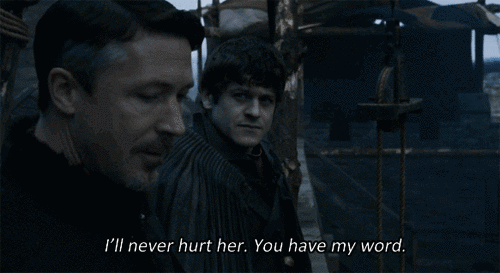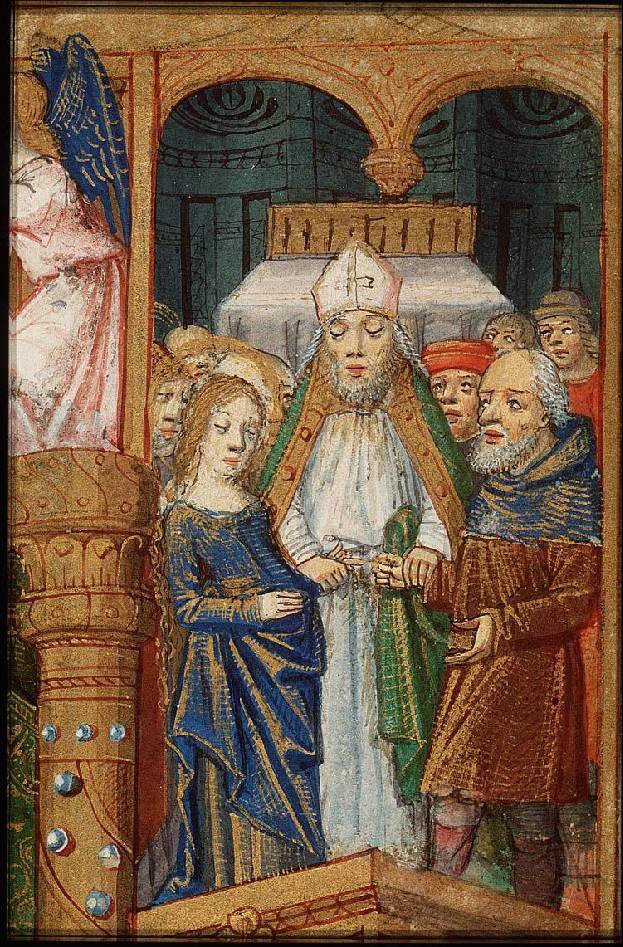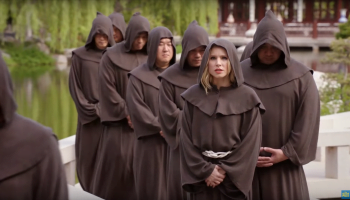Content and Spoiler Warning: The below article contains both spoilers for Season 5, Episode 6 of Game of Thrones as well as frank discussions of rape and sexual violence.
Editor’s Note: This article is significantly longer than usual for The Public Medievalist. I did this because the topic is a very difficult one, and there are a lot of issues explored here that demand a longer form to even scratch the surface. Thanks also to Amy Kaufmann for reviewing this article and offering very helpful suggestions for revision.

As a medievalist interested in popular culture, I’ve been asked by a handful of people to comment on that scene from a recent episode of Game of Thrones (season 5, episode 6). If you saw it, you probably know which one I mean: Sansa Stark is married to Ramsay Bolton—the currently-reigning Worst Person in Westeros (a title always under fierce competition). Predictably—and horribly—he then rapes her on their wedding night. At this point in the show, Sansa is many things, but not so naive as she started out. It is heavily implied that she knew what she was getting herself into, but accepted this fate so that she can get closer to the targets of her vengeance. That doesn’t make it any less horrible though—and obviously does not in any way equal consent.
Since its airing, there has been considerable discussion on the internet about that scene; some accused it of being “gratuitous.” Considering that the show is one of the most popular depictions of the medievalesque in recent years, depicting marital rape in the show this raises a number of questions about the realities of sexual violence in medieval Europe.
Our Game of Thrones Middle Ages
As a brief side-note, there are roughly two reigning versions of the Middle Ages in the popular imagination—one light, bright and merry, the other dark, muddy and bloody. The light and merry vision has been on the decline in film and TV since the 1970s (with a few notable exceptions), replaced by a more “adult,” ostensibly “realistic” depiction of the medieval world as one populated by barbaric people exacting atrocities upon one another under a darkened sky. Game of Thrones is currently the ne plus ultra of this subgenre.
Depicting the Middle Ages as bloody and brutal serves a purpose in our collective memories. We are conditioned to see ourselves as participating in a supposedly-enlightened post-modern age. The structural narratives of our age promote the idea of progress—which is as obvious in our technology as in our social ideals. Women achieved the right to vote a hundred years ago, the civil rights movement is turning 50, the gay rights movement has achieved successes at a rate that baffles even the justices of the supreme court. Our rights are getting righter—and our wrongs are being shoved into the past.
This makes the origin of our society—the medieval world—logically the worst of all possible places; the very nadir of western society (whatever that is): “The Dark Ages”. It is little wonder that the two crimes that are, arguably, worse than death—rape and torture—are understood to have been common features of the age (though they’re not, but that’s another article). It is such a good thing that we never do those any more, and instead are kept safely at arm’s length by being ascribed to our imaginary Middle Ages. To Ramsay Bolton.
Uncomfortable Answers to Uncomfortable Questions
Let me be clear: I am not saying that rape did not happen in the Middle Ages. What I am saying is that it has been one of the great horrifying constants in our society throughout every age, and that in many ways we are not so far from our medieval forebears in our perception of it. One of the questions that follows from this is not whether rape occurred, but how common it was, how acceptable it was seen to be, and whether a hypothetical medieval person watching Game of Thrones would react in the same way we do. Was Sansa’s story normal? Did every bride in the Middle Ages expect she was consigned to a life of being raped by her husband? Or was this the exception to the rule?
A chief problem in examining the problem of rape in the Middle Ages is the same problem you encounter when trying to study anything relating to the lives of women: that is, the sources. For our purposes, and without getting too far into the weeds, the best sources we have on the question of rape and whether it was acceptable are the Church doctrines and laws about marriage, the court records, diaries and literature. The problem is that most were written by men in positions of power—the voices of women, and the stories of the non-aristocratic—prove difficult to find.

The Church and “Traditional Marriage”
As a medievalist, I am frequently amused by the yawning gulf between what contemporary conservatives call “traditional marriage” that has supposedly existed unchanged for “millennia,” and the realities of marriage as it existed in the Middle Ages. What most of these conservatives don’t recognize is that the institution of marriage has always been under negotiation and interpretation. In the twelfth and thirteenth centuries, the Church fought tooth and nail to bring marriage—which had previously largely been a secular contract between families—under their exclusive control. Part of this involved intense negotiations among the clergy about sexuality: what should and shouldn’t be forbidden, what is expected of both parties in a marriage, and whether sex is required for a marriage to be valid (they eventually decided that it is).
One touchstone for the church is in Corinthians, where the Apostle Paul set a surprisingly (for him) even-handed standard:
The husband should fulfill his marital duty to his wife, and likewise the wife to her husband. The wife does not have authority over her own body but yields it to her husband. In the same way, the husband does not have authority over his own body but yields it to his wife. (1 Cor., 7:3-4)
From this, medieval church lawyers developed the “doctrine of conjugal debt”. On the surface, this seems to set a good precedent; within a marriage or long-term romantic partnership, being committed to meeting your partner’s sexual needs (as part of a general obligation to their emotional and physical wellbeing) is not necessarily a bad ideal to live by.Chaucer’s Wife of Bath famously refers to this doctrine when she demands sex from her husbands:
Why else should men into their ledgers set
That every man yield to his wife her debt?
And how can he pay this emolument
Unless he use his simple instrument?
Hurr hurr.
By contemporary feminist standards however, Paul goes way too far. It’s easy to see how being forced to give up autonomy over your body could be a huge problem—especially when society treats women, consistently, as property.
Marriage among the Medieval Aristocracy
Further complicating the issue is the fact that marriage was often not voluntary in the Middle Ages. Part of the fight over marriage (wherein the church asserted its authority over it) in the high-middle ages was about the idea of consent; prior to this, it was quite common for a person to be married to someone without their consent or even knowledge—simply arranged and sealed without any consultation. The church seems to have gotten that one right, at least.
Most people are familiar with the idea that people at that time were married very young, and that arranged marriages were the norm. I’m happy to report that this was not always the case; prepubescent betrothals were typical only for those among the aristocracy who had a limited pool of peers. As you move up the social pyramid, there are fewer and fewer people around your particular rung, which means good matches for your sons and daughters (meaning ones that increase your wealth or social standing) get a bit thin on the ground. That is certainly not to say that marriages were not arranged; they very often were. For example the History of the Counts of Guines provides a classic example of aristocratic marriages, where the eldest men of the family (often grandfathers or fathers, but sometimes uncles or even older siblings) would arrange marriages for the women in the family in order to increase their own prospects and that of their clan. Sons sometimes could find their own bride, but not always—and often only with approval from the patriarch.
If that were not bad enough for aristocratic women, there was another option for the ambitious bachelor: marriage by abduction. Yes, it was considered a valid part of “traditional marriage” during much of the Middle Ages for a man to acquire a bride by kidnapping an eligible woman and forcing her to marry him. And since, as discussed above, a marriage is not fully binding until sex, there is the implication that rape was necessarily part of this. This is not limited to thuggish petty knights roaming the countryside; both Theobald V, Count of Blois, and Geoffrey, Count of Nantes attempted to marry Eleanor of Aquitaine—then the most eligible woman in Europe—by kidnapping her. Cleverly, Eleanor managed to evade them, and afterwards elected to get married very quickly, not least to thwart these and any future plots. But what a truly horrid choice to be forced into—being required to be married out of fear that you will be kidnapped, raped and forced to marry your rapist. Making matters even worse, as Caroline Dunn argues, that lawmakers typically “neglected unwilling victims of bride-theft because their focus was on consensual elopements.” In other words, they were too busy cracking down on couples eloping against the wishes of their aristocratic families than on the women kidnapped against their will.
Marriage For Everybody Else
Outside of the machinations of the aristocracy, there is little reason to believe that for those in the vast unlanded majority that the world operated in quite this fashion. It is impossible to know without evidence what the typical model for marriage among the working majority was. But, with fewer considerations of land and dynasty—and a rather-larger pool of potential mates—the system may not have been quite so strict as for the aristocracy. But that does not at all mean that life was better for women of the lower classes.
Take as a case in point one of the major works discussing love and sex during the Middle Ages, On Love by Andreas Capellanus from the twelfth century. There is some debate over whether Capellanus was writing satire(it may be a rehash of Ovid’s Ars Amorata which was itself something of a satire), but in my opinion, he was not. He spends huge swathes of his text constructing a how-to guide for the lover (“love” here being roughly interchangeable with sex)—particularly for his aristocratic male audience in seducing a lover of an appropriate social rank. His work crystallizes the ideal of the obsessive, “chivalric” lover that so entranced the readers of the nineteenth century—but that is the topic of another article.
When it comes to loving peasants, however, Capellanus has entirely different advice. Peasants are not capable of true loving, according to him, but copulate like beasts. If you wish to engage in loving with a peasant, he offers this advice:
Be careful to puff her up with lots of praise and then, when you find a convenient place, do not hesitate to take what you seek and to embrace her by force. For you can hardly soften their outward inflexibility so far that they will grant you their embrace quietly or permit you to have the solaces you desire unless first you use a little compulsion as a convenient cure for their shyness.
The law of Jus Primae Noctis–where the lord had the right to sex with any peasant bride on his lands on her wedding night—is entirely made up (no matter what Braveheart depicts). But if Capellanus’ words are reflective of reality, then things were rather worse. The rich and powerful, it seems, were encouraged simply to take whoever they wanted by force, with little repercussions.

Rampant Medieval Ladyboners
Making matters perhaps worse, there was a fundamentally different popular perception of female desire than there is today. Whereas today there is a common perception that men are hornier–they “only have one thing on their mind” or “think about sex every seven seconds” (both of which are demonstrably false, of course), during the Middle Ages it was widely understood that women were more libidinous than men. Medieval thinkers were highly influenced by Ovid on the topic; Angeliki Laiou refers to a number of peculiar metaphors medieval thinkers came to when describing their theory:
The heat of female desire resembles wet wood, which catches fire less readily but burns longer and more strongly… The composition of the female uterus is more like iron which warms slowly but holds its heat longer… Female desire is like burning coals covered with ashes. They burn with greater heat, intensity, and duration than the more open passions of men.
But as is so often the case, women are caught by this paradigm; their allegedly “hotter” nature is yet another manifestation of their inherent sinfulness—the inheritors of Eve’s folly. In more prosaic terms, it is easy to see how this reading of female sexuality would perpetuate medieval rape culture. Like Capellanus said of peasants—they always want it, they just need provocation. As a result, even women who were raped were judged harshly by society since the common understanding was that they were at least partly responsible. Thus as Margaret Schaus argues, “many rape survivors were unable to find a marriage partner and swelled the ranks of prostitutes.”
That’s not to say that rape was not considered a crime during the Middle Ages. It was—especially when a woman’s virginity was violated. But, it was a crime that does not seem to be taken seriously unless the woman was rich and powerful. This is because the crime was considered to have perpetrated not just against the woman herself but against her entire family—her sexual purity being a valuable commodity on the marriage market, having that taken by someone was considered a serious crime.

Sansa’s Plight, and Ours
So, in essence, rape was considered a prosecutable crime in the Middle Ages, but in a very limited fashion. Like with so many things, unless you had a powerful family and not yet married, the woman was either considered to have been partially (or wholly) responsible, it was not considered a serious crime or, if she were married, no crime at all.
So, where does that leave poor Sansa—and by extension all medieval women? Would all go to their wedding beds with the expectation of being raped—or that their consent was an optional accessory rather than required? Obviously, that depends. People in every age have conformed to or pushed against the norms of their day, and historical records (e.g. court records, etc.) privilege when things go wrong. But considering the prevailing winds at the time, for a woman to discover they were being married to a partner who treated them with respect and kindness might have been more of a pleasant surprise than an expected outcome.
I am reminded of the song “Matchmaker” from Fiddler on the Roof, where three young women express their hopes and fears about being married off by their father:
Chava, I found him.
Won’t you be a lucky bride!
He’s handsome, he’s tall,
That is from side to side.But he’s a nice man, a good catch, right?
Right.You heard he has a temper.
He’ll beat you every night,
But only when he’s sober,
So you’re alright.Did you think you’d get a prince?
Well I do the best I can.
With no dowry, no money, no family background
Be glad you got a man!
But on the other hand, this raises a conundrum: to what degree does culture shape people, or do people shape culture? I find it difficult to accept that just because jurists or clerics said that marital rape was fine, (and aristocratic systems practically encouraged it) and that some poets encouraged the rape of peasants, that it means that all, or even most, men were rapists. It does mean those already inclined to be violent and sociopathic—like the Ramsays of the medieval world—would get away with it (and perhaps even be encouraged). Many might be persuadable, in the same way that warrior-groups (whether gangs or armies) often encouraged violent behavior among their members. But it does not mean that kindness and empathy ceased to exist, and that there were not people who did not “fit in” with the prevailing winds of their society.
Not all medieval men were Ramsay Bolton—though it seems as though their society encouraged them to behave more like Ramsay than like Tyrion. Many of the social norms described above are abhorrent. But it is important not to ignore medieval men’s basic humanity when trying to recuperate the basic humanity of medieval women.
And let’s not get too smug when reveling in the supposed barbarity of our medieval forebears. Marital rape was only criminalized in all 50 states in the USA in 1993—and only as a result of the concerted effort of feminists for nearly 150 years. Though figures vary, at a conservative estimate one in six women in the USA today have either been raped or are the victim of an attempted rape. And the rich and powerful still often get away with it. Women are still abducted and raped into marriage. Yes, rape culture in the medieval west was horrifying, but if the ideas explored above—that women are “asking for it,” or secretly “want it,” that women who are raped are considered “damaged goods,” or that husbands have “the right” to their wives’ bodies—if you’ve never heard those ideas, then you haven’t been paying enough attention. We still have a long way yet to go.
Click Here to donate to RAINN (Rape, Abuse and Incest National Network) the largest anti-sexual violence organization in the US. They do good work.





Psst: it’s “ne plus ultra.”
Thanks! Will make the change now.
“I find it difficult to accept that just because jurists or clerics said that marital rape was fine”
Where?? Poets yes is there firm evidence that jurists or clerics accepted it?